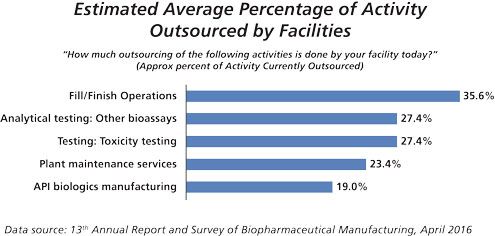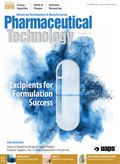Fill/Finish Outsourcing
This key bioprocessing segment is expecting continued growth
Fill/finish operations have traditionally been among the most commonly outsourced biopharmaceutical manufacturing activities. Biologics final formulation and dose filling processes require rigorous attention because they occur at the end of costly biologics manufacturing where product safety value is highest. Traditional filling involves stainless steel equipment connected through reusable valves, tubing, and piping. And because of the need for specialized equipment, expertise, and care, much of this work has been outsourced.
Stability and caution are hallmarks of this segment, and fill/finish operations are not typically characterized as part of the more rapidly changing segments. However, according to BioPlan Associates’ 13th Annual Report and Survey of Biopharmaceutical Manufacturing Capacity and Production (1), this segment remains an actively evolving area where innovation and new technologies are improving product safety and cost of goods.
Outsourcing and other fill/finish trends
To determine how the rapid advances in other bioprocessing manufacturing sectors compare to fill/finish segments, respondents to BioPlan’s survey identified the following as the most important trends in fill/finish today:
- Adoption of single-use/disposable equipment was the top trend in fill/finish activities, cited by 64% of respondents (down from 75% in 2015). Aseptic suites for final filling operations that use disposable technologies can reduce cleaning requirements and minimize risks of cross contamination. They can also be used for bulk storage containers, filters, connectors, and manifolds to minimize contamination risks and reduce downtimes.
- More multi-product-use-oriented facilities was the next-largest trend, with many also pointing to the introduction of a restricted-access barrier system (RABS) and isolator as well as more innovation for fill/finish equipment.
- Outsourcing of fill/finish may be flattening out. Respondents may have maxed out their enthusiasm for outsourcing of fill/finish as a trend. But the study indicates they will increase outsourcing to contract manufacturing organizations (CMOs) in the future.
- Smaller-footprint operations can be expected as smaller companies access new technologies and automation. Some may be able to manage more work in-house, despite the need for these smaller operations to address issues such as reducing waste.
- Robotics and automation continue to advance, as automation in filling operations further reduces risks of contamination. Most systems today, except for small manual operations, tend to be highly automated, with as few human interactions, such as loading raw materials, system changeovers, and cleaning, as possible.
- New delivery devices, such as prefilled syringes, have expanded and require changes in filling operations.
Fill/finish outsourcing may not be buzz-worthy
Outsourcing of fill/finish operations today remains a key fill/finish trend, but the percentage increases have flattened. Data indicate that almost three-quarters (74.2%) of biomanufacturers today are outsourcing fill/finish activities to at least some degree (1). This is the continuation of a steady trend of more widespread outsourcing of fill/finish dating back to 2010, when 6 in 10 respondents reported outsourcing at least some fill/finish activities. This year, fill-finish places fourth on a list of 24 outsourced activities, trailing only analytical testing of bioassays (89.7% outsourcing), plant maintenance services (80.4%), and toxicity testing (76.3%).
Further evidence of the strong state of outsourcing in the fill/finish market is also available. Respondents were surveyed concerning the average percentage of outsourcing done today (Figure 1). As expected, on average, respondents estimated outsourcing fill/finish operations to the largest degree. Indeed, the data indicate that more than one-third (35.6%) of this activity is outsourced. This figure is within the 32-27% range witnessed this decade. It also makes fill/finish easily the most heavily outsourced activity of the lot, far ahead of the next one on the list, analytical testing of bioassays (27.4% of activity outsourced).
Figure 1: Top five activities by average percentage of activity outsourced today. (Courtesy of the author)

Outsourcing of fill/finish activities is clearly commonplace and no longer considered part of the critical trends that make up the bioprocessing market. While this may change, as more innovative single-use processes and isolator technologies are introduced, filling will remain a conservative segment.
Expect more fill/finish outsourcing in the years to come
There’s reason to believe that the industry will see even more outsourcing of fill/finish activities to CMOs. Survey data demonstrate that a sizable share of the industry is planning to significantly increase its outsourcing of fill/finish operations (1).
Specifically, one in four respondents (25.4%) expect to outsource fill/finish operations at “significantly higher levels” in the coming 24 months. That figure is up from 19.7% in 2015. Still, relatively speaking, fill/finish operations are set for bigger increases than virtually any other activity measured. The only area respondents expressed greater enthusiasm about the future outsourcing was for analytical testing of bioassays, where close to one-third (31%) plan to significantly expand. Fill/finish operations even nudged API biologics manufacturing in planned increases, despite the latter’s multi-year upward trend on this measure.
But why outsourcing if in-house capacity is sufficient?
It’s interesting to view the extent to which fill/finish operations are outsourced within the context of in-house capacity. To this end, there is sufficient in-house capacity for current biopharmaceutical products, even without adding shifts or additional equipment. That view may not be held by some small-molecule fill/finish facilities, which have been operating at near-capacity due to consolidations and regulatory actions.
BioPlan estimated capacity utilization by looking at current usage against maximum capacity per shift using respondents’ current configuration for number of shifts and equipment set-up and found that capacity utilization averaged:
- 48% for vialing, down slightly from last year (50%)
- 41% for pre-filled syringes/cartridges/devices, fairly even from last year (40%)
- 58% for lyophilization, up from 52% last year.
The basis for these estimates excludes CMOs, who are major players in this industry, such that these estimates relate to in-house capacity only. This suggests that outsourcing of fill/finish activities isn’t being driven primarily by a need to expand capacity. Specialized CMOs, instead, may be viewed as having more sophisticated techniques and newer technologies. Those with newer technologies may have a competitive advantage, particularly considering that more than one-third of fill/finish respondents this year don’t plan to add any new technologies during the next 24 months.
Conclusion
The industry’s desire for improvements in fill/finish services has eased a little this year, after growing in years past. Additionally, increased outsourcing to CMOs is not seen as the key trend that it was last year.
Fill/finish activities and operations are the most heavily outsourced of any biomanufacturing activity, and each year more respondents report outsourcing fill/finish activities to at least some degree. Moreover, many respondents see significant increases in fill/finish outsourcing on the horizon. Outsourcing of fill/finish activities is certainly entrenched, even if there is ample in-house capacity. That doesn’t mean it won’t be a competitive environment for CMOs, who may well be expected to adopt or already be using technologies such as closed-vial filling and single-use fill-finish devices. All in all, outsourcing may not be buzz-worthy for fill/finish this year, but the state of fill/finish outsourcing remains quite healthy.
Reference
1. BioPlan Associates, 13th Annual Report and Survey of Biopharmaceutical Manufacturing Capacity and Production (BioPlan Associates, Inc. Rockville, MD., April 2016).
Article Details
Pharmaceutical Technology
Vol. 40, No. 10
Pages: 74–77
Citation
When referring to this article, please cite it as E. Langer, “Fill/Finish Outsourcing," Pharmaceutical Technology 40 (10) 2016.

INTERPHEX 2025: Use of Walk-In Chambers for Bio/Pharma Development and Manufacturing
April 2nd 2025Sitting down with the PharmTech Group at INTERPHEX 2025, Christopher Murphy, director of Global Business Development and Service Customer Support at Environmental Specialties, discusses the design and critical role of walk-in chambers in the bio/pharmaceutical industry.
Drug Solutions Podcast: A Closer Look at mRNA in Oncology and Vaccines
April 30th 2024In this episode fo the Drug Solutions Podcast, etherna’s vice-president of Technology and Innovation, Stefaan De Koker, discusses the merits and challenges of using mRNA as the foundation for therapeutics in oncology as well as for vaccines.